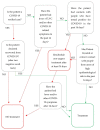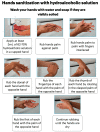Infection Control in Dental Practice During the COVID-19 Pandemic
- PMID: 32630735
- PMCID: PMC7369766
- DOI: 10.3390/ijerph17134769
Infection Control in Dental Practice During the COVID-19 Pandemic
Abstract
COVID-19 is the disease supported by SARS-CoV-2 infection, which causes a severe form of pneumonia. Due to the pathophysiological characteristics of the COVID-19 syndrome, the particular transmissibility of SARS-CoV-2, and the high globalization of our era, the epidemic emergency from China has spread rapidly all over the world. Human-to-human transmission seems to occur mainly through close contact with symptomatic people affected by COVID-19, and the main way of contagion is via the inhalation of respiratory droplets, for example when patients talk, sneeze or cough. The ability of the virus to survive outside living organisms, in aerosol or on fomites has also been recognized. The dental practitioners are particularly exposed to a high risk of SARS-CoV-2 infection because they cannot always respect the interpersonal distance of more than a meter and are exposed to saliva, blood, and other body fluids during surgical procedures. Moreover, many dental surgeries can generate aerosol, and the risk of airborne infection is to be considered higher. The aim of this paper is to provide practical advice for dentists based on the recent literature, which may be useful in reducing the risk of spreading COVID-19 during clinical practice.
Keywords: COVID-19; SARS virus; SARS-CoV-2; coronavirus infection; dentistry; guidelines; hand hygiene; infection in dentistry; prevention procedures; preventive dentistry.
Conflict of interest statement
The authors declare no conflict of interest.
Figures






References
-
- Chan J.F.-W., Yuan S., Kok K.-H., To K.K.-W., Chu H., Yang J., Xing F., Liu J., Yip C.C.-Y., Poon R.W.-S., et al. A familial cluster of pneumonia associated with the 2019 novel coronavirus indicating person-to-person transmission: A study of a family cluster. Lancet. 2020;395:514–523. doi: 10.1016/S0140-6736(20)30154-9. - DOI - PMC - PubMed
-
- Gorbalenya A.E., Baker S.C., Baric R.S., De Groot R.J., Drosten C., Gulyaeva A.A., Haagmans B.L., Lauber C., Leontovich A.M., Neuman B.W., et al. The species Severe acute respiratory syndrome-related coronavirus: Classifying 2019-nCoV and naming it SARS-CoV-2. Nat. Microbiol. 2020;5:536–544. doi: 10.1038/s41564-020-0695-z. - DOI - PMC - PubMed
Publication types
MeSH terms
LinkOut - more resources
Full Text Sources
Medical
Miscellaneous

